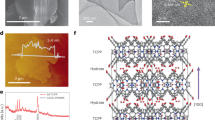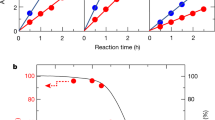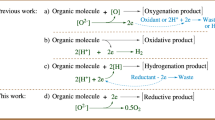Abstract
The effective utilization of solar energy requires photocatalytic reactions with high quantum efficiency. Water is the most abundant reactant that can be used as an oxygen source in efficient photocatalytic reactions, just as nature uses water in an oxygenic photosynthesis. We report that photocatalytic oxygenation of organic substrates such as sodium p-styrene sulfonate occurs with nearly 100% quantum efficiency using manganese(III) porphyrins as an oxygenation catalyst, [RuII(bpy)3]2+ (bpy = 2,2′-bipyridine) as a photosensitized electron-transfer catalyst, [CoIII(NH3)5Cl]2+ as a low-cost and weak one-electron oxidant, and water as an oxygen source in a phosphate buffer solution (pH 7.4). A high-valent manganese-oxo porphyrin is proposed as an active oxidant that effects the oxygenation reactions.
This is a preview of subscription content, access via your institution
Access options
Subscribe to this journal
Receive 12 print issues and online access
$259.00 per year
only $21.58 per issue
Buy this article
- Purchase on Springer Link
- Instant access to full article PDF
Prices may be subject to local taxes which are calculated during checkout



Similar content being viewed by others
References
Lewis, N. S. & Nocera, D. G. Powering the planet: chemical challenges in solar energy utilization. Proc. Natl Acad. Sci. USA 103, 15729–15735 (2006).
Yagi, M. & Kaneko, M. Molecular catalysts for water oxidation. Chem. Rev. 101, 21–35 (2001).
Haumann, M. et al. Photosynthetic O2 formation tracked by time-resolved X-ray experiments. Science, 310, 1019–1021 (2005).
McEvoy, J. P. & Brudvig, G. W. Water-splitting chemistry of photosystem II. Chem. Rev. 106, 4455–4483 (2006).
Yano, J. et al. Where water is oxidized to dioxygen: structure of the photosynthetic Mn4Ca cluster. Science 314, 821–825 (2006).
Barber, J. Photosynthetic energy conversion: natural and artificial. Chem. Soc. Rev. 38, 185–196 (2009).
Cytochrome P-450: Structure, Mechanism and Biochemistry 3rd edn (Kluwer/Plenum, 2005).
Schlichting, I. et al. The catalytic pathway of cytochrome P450cam at atomic resolution. Science 287, 1615–1622 (2000).
Dunford, H. B. & Stillman, J. S. On the function and mechanism of action of peroxidases. Coord. Chem. Rev. 19, 187–251 (1976).
Pérez, U. & Dunford, H. B. Spectral studies on the oxidation of organic sulfides (thioanisoles) by horseradish peroxidase compounds I and II. Biochim. Biophys. Acta 1038, 98–104 (1990).
Mlodnika, T. & James, B. R. Metalloporphyrin Catalyzed Oxidations (eds. Montanari, F. & Casella, L.) 121 (Kluwer, 1994).
Denisov, I. G. et al. Structure and chemistry of cytochrome P450. Chem. Rev. 105, 2253–2277 (2005).
Meunier, B. Metalloporphyrins as versatile catalysts for oxidation reactions and oxidative DNA cleavage. Chem. Rev. 92, 1411–1456 (1992).
Groves, J. T. et al. High-valent iron–porphyrin complexes related to peroxidase and cytochrome P-450. J. Am. Chem. Soc. 103, 2884–2886 (1981).
Groves, J. T. & Watanabe, Y. Reactive iron porphyrin derivatives related to the catalytic cycles of cytochrome P-450 and peroxidase. Studies of the mechanism of oxygen activation. J. Am. Chem. Soc. 110, 8443–8452 (1988).
Watanabe, Y. & Fujii, H. Metal–Oxo and Metal–Peroxo Species in Catalytic Oxidations (ed. Meunier, B.) 61 (Springer-Verlag, 2000).
Woo, L. K. et al. Thermodynamic and kinetic aspects of two- and three-electron redox processes mediated by nitrogen atom transfer. J. Am. Chem. Soc. 113, 8478–8484 (1991).
Groves, J. T., Lee, J. & Marla, S. S. Detection and characterization of an oxomanganese(V) porphyrin complex by rapid-mixing stopped-flow spectrophotometry. J. Am. Chem. Soc. 119, 6269–6273 (1997).
Nam, W. et al. Isolation of an oxomanganese(V) porphyrin intermediate in the reaction of a manganese(III) porphyrin complex and H2O2 in aqueous solution. Chem. Eur. J. 8, 2067–2071 (2002).
Lane, B. S. & Burgess, K. Metal-catalyzed epoxidations of alkenes with hydrogen peroxide. Chem. Rev. 103, 2457–2473 (2003).
Zhang, R., Horner, J. H. & Newcomb, M. Laser flash photolysis generation and kinetic studies of porphyrin–manganese–oxo intermediates. Rate constants for oxidations effected by porphyrin–MnV–oxo species and apparent disproportionation equilibrium constants for porphyrin–MnIV–oxo species. J. Am. Chem. Soc. 127, 6573–6582 (2005).
Hirai, Y. et al. Ruthenium-catalyzed selective and efficient oxygenation of hydrocarbons with water as an oxygen source. Angew. Chem. Int. Ed. 47, 5772–5776 (2008).
Lee, Y.-M. et al. Water as an oxygen source in the generation of mononuclear nonheme iron(IV) oxo complexes. Angew. Chem. Int. Ed. 48, 1803–1806 (2009).
Low, D. W., Winkler, J. R. & Gray, H. B. Photoinduced oxidation of microperoxidase-8: generation of ferryl and cation-radical porphyrins. J. Am. Chem. Soc. 118, 117–120 (1996).
Berglund, J. et al. Photoinduced oxidation of horseradish peroxidase. J. Am. Chem. Soc. 119, 2464–2469 (1997).
Kanan, M. W. & Nocera, D. G. In situ formation of an oxygen-evolving catalyst in neutral water containing phosphate and Co2+. Science 321, 1072–1075 (2008).
Gafney, H. D. & Adamson, A. W. Excited state Ru(bipyr)32+ as an electron-transfer reductant. J. Am. Chem. Soc. 94, 8238–8239 (1972).
Arasasingham, R. D. & Bruice, T. C. The dynamics of the reactions of methyl diphenylhydroperoxyacetate with meso-tetrakis(2,6-dimethyl-3-sulfonatophenyl)-porphinatomanganese(III) hydrate and meso-tetrakis(2,6-dichloro-3-sulfonatophenyl)-porphinatomanganese(III) hydrate and imidazole complexes. Comparison of the reactions of manganese(III) and iron(III) porphyrins. J. Am. Chem. Soc. 113, 6095–6103 (1991).
Fukuzumi, S. et al. Mechanistic insights into hydride-transfer and electron-transfer reactions by a manganese(IV)–oxo porphyrin complex. J. Am. Chem. Soc. 131, 17127–17134 (2009).
Acknowledgements
This work was supported by a Grant-in-Aid (no. 20108010 to S.F.) and a Global COE program, ‘the Global Education and Research Center for Bio-Environmental Chemistry’ from the Ministry of Education, Culture, Sports, Science and Technology, Japan (to S.F.), and The National Research Foundation (NRF) and the Ministry of Education and Science Technology (MEST) of Korea through the WCU (R31-2008-000-10010-0) and GRL (2010-00353) Programs (to S.F. and W.N.) and the Creative Research Initiatives Program (to W.N.).
Author information
Authors and Affiliations
Contributions
S.F., T.K. and W.N. conceived and designed the experiments. T.K. and H.K. performed the experiments. T.K. and H.K. analysed the data. Y.M.L. contributed materials/analysis tools. S.F. and W.N. co-wrote the paper.
Corresponding authors
Ethics declarations
Competing interests
The authors declare no competing financial interests.
Supplementary information
Supplementary information
Supplementary information (PDF 1266 kb)
Rights and permissions
About this article
Cite this article
Fukuzumi, S., Kishi, T., Kotani, H. et al. Highly efficient photocatalytic oxygenation reactions using water as an oxygen source. Nature Chem 3, 38–41 (2011). https://doi.org/10.1038/nchem.905
Received:
Accepted:
Published:
Issue Date:
DOI: https://doi.org/10.1038/nchem.905
This article is cited by
-
Hierarchical porous photosensitizers with efficient photooxidation
Nature Communications (2023)
-
Spherical cationic polymer networks with porphyrin photosensitizer for sustainable and efficient photocatalysis
Nano Research (2023)
-
Coupling photocatalytic water oxidation with reductive transformations of organic molecules
Nature Communications (2022)



